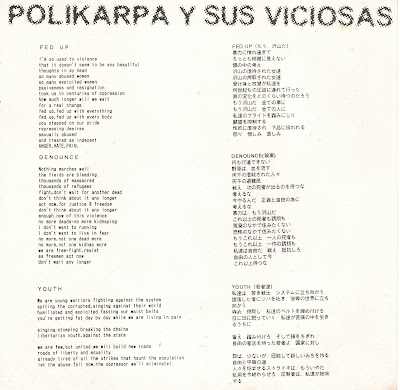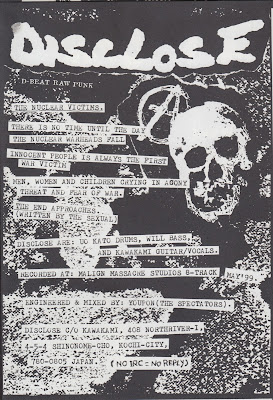The first time I saw the Contravene logo I thought it was a chicken or maybe a fat water fowl or common pigeon. It was a little bewildering. Even back then, in 2003, when my doomed quest to know everything there is to know about crust, anarchopunk and patches was still in its infancy, I already knew that there were only a couple of bird species that punk bands were legally allowed to use if they wanted to earn the bitter respect of their peers. There was the dove for the anarchopunk bands, a symbol inherited from the original 80's waves and popularized by peace-loving soap-dodging teenagers like Omega Tribe, Alternative or The Iconoclast and then re-adapted by countless crust bands like Nausea or SDS (Japanese crusties certainly love their dove). The use of this bird is something of a prerequisite in those genres if you have an anti-war song (more likely you'll have at least seven of them) and while no doves fly here in the real world, they certainly do on punk shirts.
The eagle is also an acceptable punk bird, but more of an aggressive, threatening, majestic one, sometimes used as a patriotic symbol if you are unlucky enough to be American. Some neocrust or blackened crust bands use it often. I have to say that Tragedy's take on the eagle is particularly striking and, unsurprisingly enough, it has been a popular logo. Vultures can be used as well, often in the stenchcore or metal crust imagery in order to reflect war, desolation and death, the vulture is the bird that comes when we're all already dead and we have effectively committed self-inflicted extinction. Lol.
Chickens on the other hand have never been popular punk birds for obvious reasons. It looks thick, it cannot fly with any sort of grace (when it can at all), it is certainly not threatening in the least. And to most people it symbolizes food. So why would Contravene use it at all? It did take a couple of years and a friend's compliment for me to realize that the band's logo was actually and logically a dove. I had a Contravene badge (and still do I think) with the logo because I loved the band and did not mind enduring the mockeries and ridicule in relation to wearing a chicken on my jacket. And then that friend told me something like: "Cool dove logo mate" which made me understand that it was, in fact, a dove but a short-winged, featherless one with a strange goose-like neck. But a dove nonetheless. I guess. Stupid me, I can see the dove perfectly now.
I was a big fan of the band in the 00's (I may have overplayed A Call to Action to be honest) and while I still listen to Contravene from times to times I cannot say they move me like they did back when I still had all my hair. I do see the band as a genuine 00's anarchopunk classic however and I cannot think of any other that sounded quite like them. The Phoenix-based unit were quite prolific too with one Lp, two Ep's and two split Ep's under their vegan belt in only six years (between 2000 and 2003 actually) so that if you were into DIY political punk at that time you would have heard of them, even more so since they toured in Europe in 2001 (or something? I was too busy listening to streetpunk dross in 2001 and missed them like a bellend). In addition Contravene were from Arizona and while areas like Portland, New York, Minneapolis or any Californian shitholes were deemed "cool" and would attract punters regardless of the bands on stage, Arizona was not exactly the trendiest punk place and that made them a little more special in my eyes as a result. They were very outspoken politically, very serious, very passionate and supported revolutionary ideals (there is the obligatory political text about multiple oppressions with the Ep) and it made them quite inspiring in a lot of respects. They had that kind of youthful energy and belief that matter and their lyrics are every bit as relevant today, sadly I must add.
And well, they were quite unique musically too. Not perfect and listening to them carefully and critically again, there are bits that don't quite work but I don't think it really matters because they had all that sincerity and they did strive to create their own brand of anarchopunk (to an extent, it is not like they went all experimental and played the guitar with forks like The Ex did) which makes them remarkable. Their side of this split is made up of one long song, recorded in early 2000. "Stand up and resist" is classic Contravene in all its glory. It opens with a sample of a political speech then proceeds with a rather melancholy and melodic, mid-paced, short introduction before unleashing the dark and heavy crusty riffs with a singalong chorus, then some sort of metallic-yet-melodic instrumental moment, then back to the fast crust riffs and then, as an epic conclusion, the same arpeggio tune as on the opening is back this time with more dynamics and catchy poppy backing chorus. Contravene were great at telling stories with their songs, that were often quite long for the genre, through the use of introductions, conclusions, twists or transitions and on this number it works flawlessly.
They have often been compared to Nausea, probably because of the strong shouted female vocals, but they were more tuneful and versatile. They definitely belonged to that 90's wave of female-fronted US anarchopunk of classic bands like Antiproduct or Mankind? but they were also heavier, metallic and crustier like the aforementioned Nausea and even European bands like Homomilitia (the fact that some members from the band also played in Misanthropic and Sea of Deprivation accounts for the metallic sound). What made them really stand out was their surprisingly melodic poppy moments reminiscent of Civilised Society and even Chumbawamba or Omega Tribe - I love anarcho-cheesy and Contravene sometimes did go full out which can scare some eway - although the production is always on the heavy side. It might be too melodic for the crustier-than-thou and too heavy and metallic for the lovers of traditional anarchopunk but in the end that was what made Contravene who they were. One of the most relevant anarchopunk bands of their generation.
On the other side Svart Aggression were a perfect choice for a split with the Arizonians, full of significance and meaning. Hailing from Kalmar, the band is mostly known nowadays (and by "mostly known" I mean that I have one mate locally who knows the band because they did do a split with Kaaos, which is pretty brilliant) for their connection with Protestera with whom they shared two members in the early days. One year before Operation, a criminally overlooked angry Swedish anarchopunk band, officially folded, two members of the band formed Svart Aggression. In 1999 Protestera, basically the progression from Operation, started and both bands sounded very similar in the beginning, fast and angry 90's aanrchopunk, pretty much the same people under a different name. While oft forgotten when one meditates about 90's Swedish hardcore, crust and d-beat, Svart Aggression certainly deserves to be rediscovered, if only because they were a little different and did not quite fit the orthodox Distortion Records template.
In some respect Svart Aggression unintentionally stood for some stylistic transitions that took place between the late 90's and the 00's in Sweden as some bands started to add different influences to the otherwise fairly classic scandicrust recipe. The furious and savage käng attack is present with the cracking song "Mördare" and its traditionally pummeling fast d-takt and epic crunchy hardcore riffs, not unlike Tolshock maybe, but there are also heavier elements with a down-tuned melancholy vibe like on the introduction to "Skit system" and its slow d-beat. Pretty much how the so-called neocrust wave would work just a few years afterwards but I suppose it was more the dark Wolfpack influence speaking in this case. The dual male and female vocals really gives the band that classic anarchopunk feeling that already prevailed in Operation - and many other bands in the 90's and early 00's - and on the whole you could see Svart Aggression as a sort of Swedish version of React. I love how the two vocalists work together as Emma has a very peculiar way of singing that is almost spoken but still powerful and that balances well with Coffe's raspy aggressive käng shouts. A genuinely great combination. These two songs were recorded in late 1999 during the same session as the five songs that would eventually appear on the brilliant Tänk Själv Ep in 2006 released on Scream Records (although the label does not appear on the backcover, in true DIY fashion, a small promotional flyer from Scream Records referencing the Ep was actually included in the Ep) but, not owning the split with Kaaos, released in 2000 like the present record, I can't tell you if the two songs it has were also taken during the same session.
This split Ep was released on Catchphraze Records, a label based in Arizona that was responsible for records by Axiom, Inner Conflict and all of Contravene's. The label also ran a small distro that sold DIY tape versions of old, sold-out records that were seemingly impossible to find - to me anyway - and I remember ordering several tapes from them around 2003, notably Sacrilege's first Lp on a very simple dubbed tape with a xerox cover. Needless to say it severely kicked my ass. So thank you Catchphraze.







































































